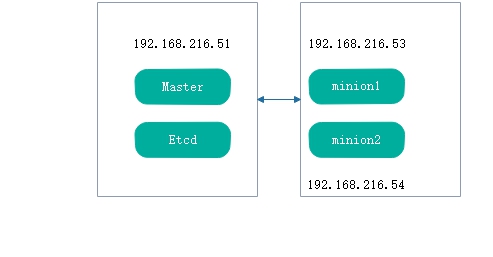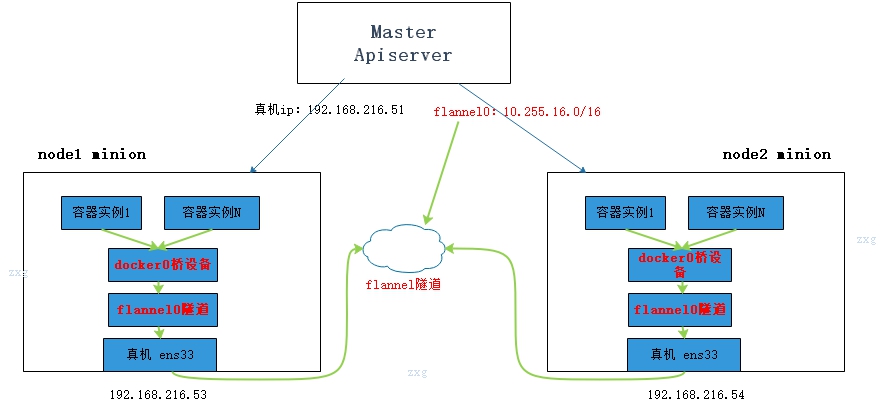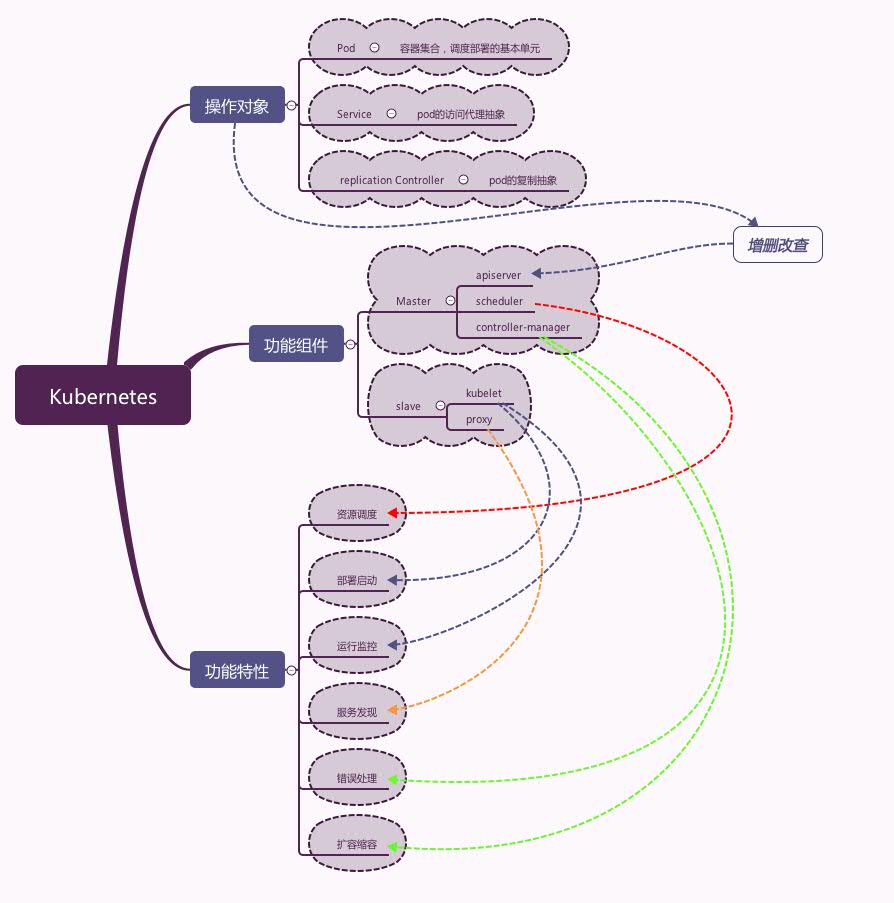一、简介
1、环境依旧是kubernetes之前文章的架构

2、需要docker的镜像
1)php-forntend web 前端镜像
docker.io-kubeguide-guestbook-php-frontend.tar
2)redis master
docker.io-kubeguide-redis-master.tar
3)redis slave
docker.io-kubeguide-guestbook-redis-slave.tar
web前端通过javascript redis api 和redis master交互,可以在阿里上或自行下载
3、架构示意图

4、底层网络架构图

5、补充kubernetes系统架构图

二、开始部署
1、上传导入镜像
先下载相关镜像
互联网自行下载,或者直接docker pull
docker load导入
[root@node1 k8s]# docker load -i docker.io-kubeguide-redis-master.tar #---导入redis-master [root@node1 k8s]# docker load -i docker.io-kubeguide-guestbook-php-frontend.tar #---导入guestbook-php-frontend [root@node1 k8s]# docker load -i docker.io-kubeguide-guestbook-redis-slave.tar #---导入guestbook-redis-slave
2、创建redis master deployment配置文件
回顾:deployment作用,是描述想要的目标状态是什么
1)创建vim redis-master-deployment.yaml
[root@master k8s]# cd /etc/kubernetes/yaml/
[root@master k8s]# vim redis-master-deployment.yaml apiVersion: extensions/v1beta1 kind: Deployment metadata: name: redis-master # these labels can be applied automatically # from the labels in the pod template if not set #---如果没有设置,这些标签可以自动应用于POD模板中的标签 # labels: # app: redis # role: master # tier: backend spec: # this replicas value is default # modify it according to your case replicas: 1 #---此副本值,根据情况修改 # selector can be applied automatically # from the labels in the pod template if not set #---如果没有设置 # selector: # matchLabels: # app: guestbook # role: master # tier: backend template: #---模板,如果没有设置,选择自动使用从此模板中默认的标签 metadata: labels: app: redis role: master tier: backend spec: containers: - name: master image: docker.io/kubeguide/redis-master:latest #---自行修改,镜像地址 imagePullPolicy: IfNotPresent resources: requests: cpu: 100m memory: 100Mi ports: - containerPort: 6379
2)启动这个deployment
[root@master yaml]# kubectl create -f /etc/kubernetes/yaml/redis-master-deployment.yaml deployment "redis-master" created [root@master yaml]# kubectl get deployment NAME DESIRED CURRENT UP-TO-DATE AVAILABLE AGE nginx 2 2 2 2 21h redis-master 1 1 1 1 4s [root@master yaml]# kubectl get deployment NAME DESIRED CURRENT UP-TO-DATE AVAILABLE AGE nginx 2 2 2 2 21h redis-master 1 1 1 1 6s
3、创建redis master service配置文件
1)编辑redis-master-service.yaml
[root@master yaml]# vim /etc/kubernetes/yaml/redis-master-service.yaml apiVersion: v1 kind: Service metadata: #---metadata.name定义了service的服务名,spec.selector确定了pod对应到本服务 name: redis-master labels: #---这里的定义表面拥有redis-master标签的pod属于redis-master服务 app: redis role: master tier: backend spec: ports: # the port that this service should serve on - port: 6379 #---ports部分中targetport属性用来确定提供该服务的容器所暴露(expose)的端口号,port定义server的虚拟端口 targetPort: 6379 selector: app: redis role: master tier: backend
2)启动这个service
[root@master yaml]# kubectl create -f /etc/kubernetes/yaml/redis-master-service.yaml service "redis-master" created [root@master yaml]# kubectl get svc NAME CLUSTER-IP EXTERNAL-IP PORT(S) AGE kubernetes 10.254.0.1 <none> 443/TCP 14d nginx 10.254.8.125 <nodes> 80:31011/TCP 9d redis-master 10.254.16.93 <none> 6379/TCP 6s [root@master yaml]#
4、创建redis slave deployment配置文件
1)创建redis-salve-deployment
[root@master yaml]# vim redis-slave-deployment.yaml apiVersion: extensions/v1beta1 kind: Deployment metadata: name: redis-slave # these labels can be applied automatically # from the labels in the pod template if not set # labels: # app: redis # role: slave # tier: backend spec: # this replicas value is default # modify it according to your case replicas: 2 # selector can be applied automatically # from the labels in the pod template if not set # selector: # matchLabels: # app: guestbook # role: slave # tier: backend template: metadata: labels: app: redis role: slave tier: backend spec: containers: - name: slave image: docker.io/kubeguide/guestbook-redis-slave:latest imagePullPolicy: IfNotPresent resources: requests: cpu: 100m memory: 100Mi env: - name: GET_HOSTS_FROM value: env # If your cluster config does not include a dns service, then to # instead access an environment variable to find the master # service's host, comment out the 'value: dns' line above, and # uncomment the line below. # value: env ports: - containerPort: 6379
2)启动redis-slave-deployment
[root@master yaml]# kubectl create -f /etc/kubernetes/yaml/redis-slave-deployment.yaml deployment "redis-slave" created [root@master yaml]# kubectl get deploy #---查看deployment NAME DESIRED CURRENT UP-TO-DATE AVAILABLE AGE nginx 2 2 2 2 22h redis-master 1 1 1 1 11m redis-slave 2 2 2 2 7s [root@master yaml]# kubectl get pods #---查看pods NAME READY STATUS RESTARTS AGE nginx-2187705812-n5wsr 1/1 Running 1 22h nginx-2187705812-zngv0 1/1 Running 1 22h redis-master-3671804942-vjx86 1/1 Running 0 30m redis-slave-2377017994-9nk3l 1/1 Running 0 19m redis-slave-2377017994-vfd4b 1/1 Running 0 19m [root@master yaml]# kubectl get pods -o wide #---查看pod 详细信息,可以看到一个master两个slave NAME READY STATUS RESTARTS AGE IP NODE nginx-2187705812-n5wsr 1/1 Running 1 22h 10.255.101.2 node2 nginx-2187705812-zngv0 1/1 Running 1 22h 10.255.58.2 node1 redis-master-3671804942-vjx86 1/1 Running 0 31m 10.255.58.3 node1 redis-slave-2377017994-9nk3l 1/1 Running 0 19m 10.255.101.4 node2 redis-slave-2377017994-vfd4b 1/1 Running 0 19m 10.255.58.4 node1 [root@master yaml]#
5、创建slave service 配置文件
1)创建redis-slave-service.yaml
[root@master yaml]# vim /etc/kubernetes/yaml/redis-slave-service.yaml apiVersion: v1 kind: Service metadata: name: redis-slave labels: app: redis role: slave tier: backend spec: ports: # the port that this service should serve on - port: 6379 selector: app: redis role: slave tier: backend
2)启动这service
[root@master yaml]# kubectl create -f /etc/kubernetes/yaml/redis-slave-service.yaml service "redis-slave" created [root@master yaml]# kubectl get svc -o wide NAME CLUSTER-IP EXTERNAL-IP PORT(S) AGE SELECTOR kubernetes 10.254.0.1 <none> 443/TCP 14d <none> nginx 10.254.8.125 <nodes> 80:31011/TCP 9d name=nginx redis-master 10.254.16.93 <none> 6379/TCP 32m app=redis,role=master,tier=backend redis-slave 10.254.22.156 <none> 6379/TCP 10s app=redis,role=slave,tier=backend [root@master yaml]#
6、创建fronteng guestbook deployment配置文件
这个是一个简单的PHP服务,用来和master service (写请求),slave service(读请求)交互
1)创建编辑frontend-deployment.yaml
[root@master yaml]# vim frontend-deployment.yaml apiVersion: extensions/v1beta1 kind: Deployment metadata: name: frontend # these labels can be applied automatically # from the labels in the pod template if not set # labels: # app: guestbook # tier: frontend spec: # this replicas value is default # modify it according to your case replicas: 3 # selector can be applied automatically # from the labels in the pod template if not set # selector: # matchLabels: # app: guestbook # tier: frontend template: metadata: labels: app: guestbook tier: frontend spec: containers: - name: php-redis image: docker.io/kubeguide/guestbook-php-frontend:latest imagePullPolicy: IfNotPresent resources: requests: cpu: 100m memory: 100Mi env: - name: GET_HOSTS_FROM value: env # If your cluster config does not include a dns service, then to # instead access environment variables to find service host # info, comment out the 'value: dns' line above, and uncomment the # line below. # value: env ports: - containerPort: 80
2)启动这个deployment
可以看到三个frontend,一个master,两个slave
[root@master yaml]# kubectl create -f frontend-deployment.yaml deployment "frontend" created [root@master yaml]# kubectl get deploy NAME DESIRED CURRENT UP-TO-DATE AVAILABLE AGE frontend 3 3 3 3 10s nginx 2 2 2 2 22h redis-master 1 1 1 1 48m redis-slave 2 2 2 2 37m [root@master yaml]# kubectl get pods -o wide NAME READY STATUS RESTARTS AGE IP NODE frontend-1186687533-0g08q 1/1 Running 0 24s 10.255.58.5 node1 frontend-1186687533-fxf29 1/1 Running 0 24s 10.255.101.5 node2 frontend-1186687533-q38fx 1/1 Running 0 24s 10.255.101.6 node2 nginx-2187705812-n5wsr 1/1 Running 1 22h 10.255.101.2 node2 nginx-2187705812-zngv0 1/1 Running 1 22h 10.255.58.2 node1 redis-master-3671804942-vjx86 1/1 Running 0 49m 10.255.58.3 node1 redis-slave-2377017994-9nk3l 1/1 Running 0 37m 10.255.101.4 node2 redis-slave-2377017994-vfd4b 1/1 Running 0 37m 10.255.58.4 node1 [root@master yaml]#
7、创建frontend guestbook service 配置文件
1)创建frontend-service.yaml
[root@master yaml]# vim frontend-service.yaml apiVersion: v1 kind: Service metadata: name: frontend labels: app: guestbook tier: frontend spec: # if your cluster supports it, uncomment the following to automatically create # an external load-balanced IP for the frontend service. # type: LoadBalancer type: NodePort ports: # the port that this service should serve on - port: 80 nodePort: 30001 selector: app: guestbook tier: frontend
2)启动这个service
[root@master yaml]# kubectl create -f /etc/kubernetes/yaml/frontend-service.yaml service "frontend" created [root@master yaml]# kubectl get svc -o wide NAME CLUSTER-IP EXTERNAL-IP PORT(S) AGE SELECTOR frontend 10.254.129.194 <nodes> 80:30001/TCP 4m app=guestbook,tier=frontend kubernetes 10.254.0.1 <none> 443/TCP 14d <none> nginx 10.254.8.125 <nodes> 80:31011/TCP 9d name=nginx redis-master 10.254.16.93 <none> 6379/TCP 52m app=redis,role=master,tier=backend redis-slave 10.254.22.156 <none> 6379/TCP 20m app=redis,role=slave,tier=backend [root@master yaml]#
3)node1 查看端口
[root@node1 k8s]# netstat -antup |grep 30001
tcp6 0 0 :::30001 :::* LISTEN 1110/kube-proxy
三、验证
1、访问web端
http://192.168.216.53:30001/

参考:互联网内容
总结流程:准备deployment和service配置文件》导入镜像》启动deployment和service
kubernetes系列文章请见:
部署:请见Kubernetes2-K8s的集群部署
kubectl:请见Kubernetes3-kubectl管理Kubernetes容器平台-1
kubectl:请见Kubernetes3-kubectl管理Kubernetes容器平台-2
Kubernetes Dashboard web界面:请见Kubernetes4-web管理界面